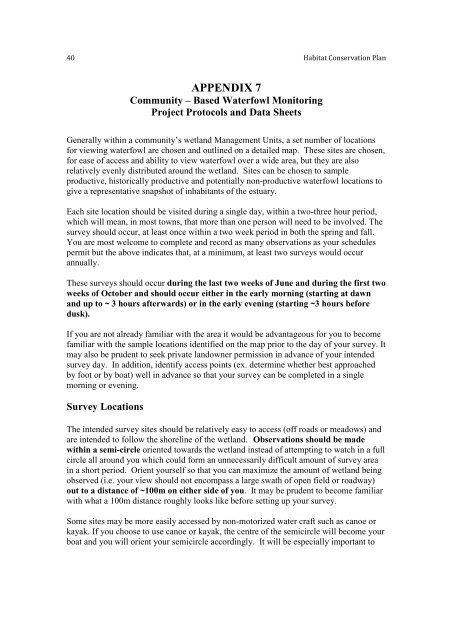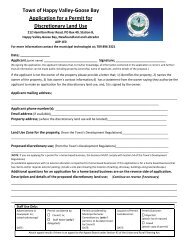Habitat Conservation Plan Habitat Conservation Plan for the Town ...
Habitat Conservation Plan Habitat Conservation Plan for the Town ...
Habitat Conservation Plan Habitat Conservation Plan for the Town ...
- No tags were found...
Create successful ePaper yourself
Turn your PDF publications into a flip-book with our unique Google optimized e-Paper software.
40 <strong>Habitat</strong> <strong>Conservation</strong> <strong>Plan</strong>APPENDIX 7Community – Based Waterfowl MonitoringProject Protocols and Data SheetsGenerally within a community’s wetland Management Units, a set number of locations<strong>for</strong> viewing waterfowl are chosen and outlined on a detailed map. These sites are chosen,<strong>for</strong> ease of access and ability to view waterfowl over a wide area, but <strong>the</strong>y are alsorelatively evenly distributed around <strong>the</strong> wetland. Sites can be chosen to sampleproductive, historically productive and potentially non-productive waterfowl locations togive a representative snapshot of inhabitants of <strong>the</strong> estuary.Each site location should be visited during a single day, within a two-three hour period,which will mean, in most towns, that more than one person will need to be involved. Thesurvey should occur, at least once within a two week period in both <strong>the</strong> spring and fall.You are most welcome to complete and record as many observations as your schedulespermit but <strong>the</strong> above indicates that, at a minimum, at least two surveys would occurannually.These surveys should occur during <strong>the</strong> last two weeks of June and during <strong>the</strong> first twoweeks of October and should occur ei<strong>the</strong>r in <strong>the</strong> early morning (starting at dawnand up to ~ 3 hours afterwards) or in <strong>the</strong> early evening (starting ~3 hours be<strong>for</strong>edusk).If you are not already familiar with <strong>the</strong> area it would be advantageous <strong>for</strong> you to becomefamiliar with <strong>the</strong> sample locations identified on <strong>the</strong> map prior to <strong>the</strong> day of your survey. Itmay also be prudent to seek private landowner permission in advance of your intendedsurvey day. In addition, identify access points (ex. determine whe<strong>the</strong>r best approachedby foot or by boat) well in advance so that your survey can be completed in a singlemorning or evening.Survey LocationsThe intended survey sites should be relatively easy to access (off roads or meadows) andare intended to follow <strong>the</strong> shoreline of <strong>the</strong> wetland. Observations should be madewithin a semi-circle oriented towards <strong>the</strong> wetland instead of attempting to watch in a fullcircle all around you which could <strong>for</strong>m an unnecessarily difficult amount of survey areain a short period. Orient yourself so that you can maximize <strong>the</strong> amount of wetland beingobserved (i.e. your view should not encompass a large swath of open field or roadway)out to a distance of ~100m on ei<strong>the</strong>r side of you. It may be prudent to become familiarwith what a 100m distance roughly looks like be<strong>for</strong>e setting up your survey.Some sites may be more easily accessed by non-motorized water craft such as canoe orkayak. If you choose to use canoe or kayak, <strong>the</strong> centre of <strong>the</strong> semicircle will become yourboat and you will orient your semicircle accordingly. It will be especially important to






